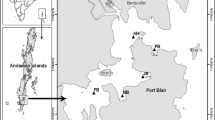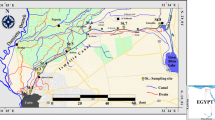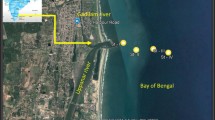Abstract
Aulacoseira granulata (Ehrenberg) Simonsen 1979 are considered as the eco-variable species which varies in density and diversity along with their morphological traits with the interference of environmental changes, so it is considered as one of the major ecological indicators of the water quality of lotic as well as lentic aquatic ecosystems. To assess major environmental factors which contribute to A. granulata bloom in the riverine system, a study was carried out from 2018 to 2019 comprising four different seasons at 11 sampling sites of river Ganga in the middle and lower stretch of river Ganga comprising freshwater and estuarine zones. For the analysis, different univariate, as well as multivariate, analytical tools such as principal component analysis (PCA) and water pollution index (WPI) were used. In the finding, it was observed that the average abundance of A. granulata was found maximum during the winter season. Among all the studied sites, the maximum average abundance was at Balagarh (71,576 cell l−1) and minimum at Diamond Harbour (68 cell l−1). The environmental factors such as dissolved oxygen, depth, and altitude showed a significant influence on the growth of A. granulata, while the water temperature negatively influenced the growth rate of A. granulata. The WPI showed a significantly negative correlation with cell length. Finally, the study concludes that the blooming of A. granulata is highly influenced by varied environmental conditions along the river Ganga, suggesting possible eutrophication. Therefore, a certain minimum flow and depth especially during the lean season have to be maintained for the sustenance of planktonic biota in the river Ganga.







Similar content being viewed by others
Data availability
Not applicable.
References
Al-Husseini KH, Alsalman AIM (2020) Quarterly variation and their impact on phytoplankton dynamics in the Gharraf River environment in southern Iraq. Plant Arch 20:1354–1360
Ambwani K, Sahni A, Kar RK, Dutta D (2003) Oldest known non-marine diatoms (Aulacoseira) from the uppermost Cretaceous Deccan Intertrappean Beds and Lameta Formation of India. Rev Micropaléontologie 46:67–71
American Public Health Association (2017) Standard methods for the examination of water and wastewater. Washington, Dc, USA. Chapter 2000 pp, 1–105
Atique U, An K-G (2019) Reservoir water quality assessment based on chemical parameters and the chlorophyll dynamics in relation to nutrient regime. Polish J Environ Stud 28:
Atique U, An K-G (2020) Landscape heterogeneity impacts water chemistry, nutrient regime, organic matter and chlorophyll dynamics in agricultural reservoirs. Ecol Indic 110:105813
Ayoade AA, Agarwal NK, Chandola-Saklani A (2009) Changes in physicochemical features and plankton of two regulated high altitude rivers Garhwal Himalaya, India. Eur J Sci Res 27:77–92
Bargu S, White JR, Li C et al (2011) Effects of freshwater input on nutrient loading, phytoplankton biomass, and cyanotoxin production in an oligohaline estuarine lake. Hydrobiologia 661:377–389
Bedoshvili YD, Bondarenko NA, Sakirko M V, Likhoshvay E V (2007) The change in the length of colonies of the planktonic diatom Aulacoseira baicalensis in various stages of the annual cycle in Lake Baikal. Hydrobiol J 43:
Bicudo DC, Tremarin PI, Almeida PD et al (2016) Ecology and distribution of Aulacoseira species (Bacillariophyta) in tropical reservoirs from Brazil. Diatom Res 31:199–215
Blum JL (1957) An ecological study of the algae of the Saline River, Michigan. Hydrobiologia 9:361–408
Chakraborty B, Roy S, Bera A, et al (2021) Cleaning the river Damodar (India): impact of COVID-19 lockdown on water quality and future rejuvenation strategies. Environ Dev Sustain 1–15
Chong W, Huang Y, Shengbing H et al (2009) Variation of phytoplankton community before an induced cyanobacterial (Arthrospira platensis) bloom. J Environ Sci 21:1632–1638
Cox EJ, Cox EJ (1996) Identification of freshwater diatoms from live material. Chapman & Hall London
Cupp EE (1943) Marine plankton diatoms of the west coast of North America
Dimri D, Daverey A, Kumar A, Sharma A (2021) Monitoring water quality of River Ganga using multivariate techniques and WQI (water quality index) in Western Himalayan region of Uttarakhand, India. Environ Nanotechnology Monit Manag 15:100375
Dodds WK, Jones JR, Welch EB (1998) Suggested classification of stream trophic state: distributions of temperate stream types by chlorophyll, total nitrogen, and phosphorus. Water Res 32:1455–1462
Grigoryeva IL, Komissarov AB, Kuzovlev VV, Chekmareva EA (2019) Influence of thermal pollution on the ecological conditions in cooling reservoirs. Water Resour 46:S101–S109
Guinder VA, Malits A, Ferronato C et al (2020) Microbial plankton configuration in the epipelagic realm from the Beagle Channel to the Burdwood Bank, a marine protected area in sub-Antarctic waters. PLoS One 15:e0233156
Guiry MD, Guiry GM (2014) AlgaeBase.[Online]. National University of Ireland, Galway
Guiry MD, Guiry GM (2021) AlgaeBase. World-wide electronic publication, National University of Ireland, Galway. http://www.algaebase.org. Accessed 3 Jul 2021
Ha K, Jang M-H, Joo G-J (2003) Winter Stephanodiscus bloom development in the Nakdong River regulated by an estuary dam and tributaries. Hydrobiologia 506:221–227
Herawati EY, Khasanah RI, Ambarwati M, Sofarini D (2020) The effect of hydro-oceanographic factors on the community structure of plankton in natural and artificial coral reefs in Paiton waters. Aquac Aquarium Conserv Legis 13:71–85
Hong J, Lee S, Lee K, Hong J (2020) Seasonal variations in the surface energy and CO2 flux over a high-rise, high-population, residential urban area in the East Asian monsoon region. Int J Climatol 40:4384–4407
Hossain MY, Jewel MAS, Fulanda B, et al (2012) Dynamics of cyanobacteria Planktothrix species (Oscillatoriales: Phormidiaceae) in earthen fish ponds, northwestern Bangladesh
Hötzel G, Croome R (1996) Population dynamics of Aulacoseira granulata (EHR.) Simonson (Bacillariophyceae, Centrales), the dominant alga in the Murray River, Australia. Arch für Hydrobiol 191–215
Jewson DH (1992) Size reduction, reproductive strategy and the life cycle of a centric diatom. Philos Trans R Soc London Ser B Biol Sci 336:191–213
Jia X-H, Jiang W-X, Li F-Q et al (2009) Impacts of large hydropower station on benthic algal communities. Ying yong sheng tai xue bao=. J Appl Ecol 20:1731–1738
Joung S-H, Park H-K, Lee H-J, Lee S-H (2013) Effect of climate change for diatom bloom at winter and spring season in Mulgeum Station of the Nakdong River, South Korea. J Korean Soc Water Environ 29:155–164
Kanaya G, Kikuchi E (2008) Spatial changes in a macrozoobenthic community along environmental gradients in a shallow brackish lagoon facing Sendai Bay, Japan. Estuar Coast Shelf Sci 78:674–684
Kilham SS, Kilham P (1975) Melosira granulata (Ehr.) Ralfs: morphology and ecology of a cosmopolitan freshwater diatom: with 2 figures and 1 table in the text. Int Vereinigung Für Theor Und Angew Limnol Verhandlungen 19:2716–2721
Kulikovskiy MS, Glushchenko AM, Genkal SI, Kuznetsova I V (2016) Identification book of diatoms from Russia. Filigran, Yarosl
Lakshminarayana JSS (1965) Studies on the phytoplankton of the River Ganges, Varanasi, India, Part II “The seasonal growth and succession of the plankton algae in the River Ganges.” Hydrobiologia 25:138–165
Lee H-J, An K-G (2009) The development and application of multi-metric water quality assessment model for reservoir managements in Korea. Korean J Ecol Environ 42:242–252
Margalef R (1983) Limnología. Omega Barcelona
Matta G, Kumar A, Nayak A et al (2020) Water quality and planktonic composition of river Henwal (India) using comprehensive pollution index and biotic-indices. Trans Indian Natl Acad Eng 5:541–553
Mayama S (1991) Taxonomic revisions to the differentiating diatom groups for water quality evaluation and some comments for taxa with new designations. Nov Hedwigia 52:
Moeller HV, Laufkötter C, Sweeney EM, Johnson MD (2019) Light-dependent grazing can drive formation and deepening of deep chlorophyll maxima. Nat Commun 10:1–8
Moro RS (1991) Morphology of Aulacoseira-granulata (EHR) Simonsen var australiensis (Grunow) nov-comb under light-microscopy. Arq Biol e Tecnol 34:353–359
Nwankwegu AS, Li Y, Huang Y et al (2019) Harmful algal blooms under changing climate and constantly increasing anthropogenic actions: the review of management implications. 3 Biotech 9:1–19
Pandey U, Pandey J, Singh A V, Mishra A (2017) Anthropogenic drivers shift diatom dominance–diversity relationships and transparent exopolymeric particles production in river Ganga: implication for natural cleaning of river water. Curr Sci 959–964
Parakkandi J, Saha A, Sarkar UK et al (2021) Spatial and temporal dynamics of phytoplankton in association with habitat parameters in a tropical reservoir, India. Arab J Geosci 14:1–15
Parmar TK, Rawtani D, Agrawal YK (2016) Bioindicators: the natural indicator of environmental pollution. Front Life Sci 9:110–118
Pathak V, Tyagi RK (2010) Riverine ecology and fisheries vis-a-vis hydrodynamic alterations. CIFRI Bull 35
Pham L (2017) Comparison between water quality index (WQI) and biological indices, based on planktonic diatom for water quality assessment in the Dong Nai River. Vietnam Pollution 3:311–323
Poister D, Kurth A, Farrell A, Gray S (2012) Seasonality of Aulacoseira ambigua abundance and filament length: biogeochemical implications. Plankt Benthos Res 7:55–63
Poister D, Schaefer A, Baert A et al (2015) Stimulated rejuvenation of dormant Aulacoseira granulata (Bacillariophyta) by Gloeocystis planctonica (Chlorophyta) in a eutrophic river. J Phycol 51:332–342
Popovic NZ, Duknic JA, Atlagic JZ et al (2016) Application of the water pollution index in the assessment of the ecological status of rivers: a case study of the Sava River, Serbia. Acta Zool Bulg 68:97–102
Pratiwi NTM (2019) Community structure of plankton at Central Kalimantan peat swamp area. In: IOP conference series: earth and environmental science. IOP Publishing, p 12003
Quincey DJ (2017) The Himalayan climate and water atlas. Mt Res Dev 37:155–156
Rakshit N, Banerjee A, Mukherjee J et al (2017) Comparative study of food webs from two different time periods of Hooghly Matla estuarine system, India through network analysis. Ecol Modell 356:25–37
Rimet F, Bouchez A, Montuelle B (2015) Benthic diatoms and phytoplankton to assess nutrients in a large lake: complementarity of their use in Lake Geneva (France–Switzerland). Ecol Indic 53:231–239
Roshith CM, Meena DK, Manna RK et al (2018) Phytoplankton community structure of the Gangetic (Hooghly-Matla) estuary: status and ecological implications in relation to eco-climatic variability. Flora 240:133–143
Sanghi R (2013) Our national river Ganga: lifeline of millions. Springer Science & Business Media
Sekerci Y, Petrovskii S (2018) Global warming can lead to depletion of oxygen by disrupting phytoplankton photosynthesis: a mathematical modelling approach. Geosciences 8:201
Shende S, Rathoure AK (2019) Physico-chemical properties of Erai River in monsoon near Chandrapur City (Maharashtra) India
Simonsen R (1979) The diatom system: ideas on phylogeny. Bacillaria 2:9–71
Singh KR, Dutta R, Kalamdhad AS, Kumar B (2019) Information entropy as a tool in surface water quality assessment. Environ Earth Sci 78:15
Srivastava K, Mishra S, Verma HO, et al (2020) Time scale changes of plankton in the river Ganga at Kanpur
Srivastava P, Verma J, Grover S, Sardar A (2016) On the importance of diatoms as ecological indicators in river ecosystems: a review. Indian J Plant Sci 5:70–86
Taylor JC, Harding WR, Archibald CGM (2007) An illustrated guide to some common diatom species from South Africa. Water Research Commission Pretoria
Thomas MK, Aranguren-Gassis M, Kremer CT et al (2017) Temperature–nutrient interactions exacerbate sensitivity to warming in phytoplankton. Glob Chang Biol 23:3269–3280
Tripathi S, Gopesh A, Dwivedi AC (2017) Fish and fisheries in the Ganga river: current assessment of the fish community, threats and restoration. J Exp Zool India 907–912
Tsai Y-C, Chen K-C, Cheng T-S et al (2019) Chlorophyll fluorescence analysis in diverse rice varieties reveals the positive correlation between the seedlings salt tolerance and photosynthetic efficiency. BMC Plant Biol 19:1–17
Wang C, Lek S, Lai Z, Tudesque L (2017) Morphology of Aulacoseira filaments as indicator of the aquatic environment in a large subtropical river: the Pearl River, China. Ecol Indic 81:325–332
Wang C, Wu N, Li W et al (2020) Curved filaments of Aulacoseira complex as ecological indicators in the Pearl River. China. Ecol Indic 118:106722
Wang Q, Wu X, Zhao B et al (2015) Combined multivariate statistical techniques, water pollution index (WPI) and Daniel trend test methods to evaluate temporal and spatial variations and trends of water quality at Shanchong River in the Northwest Basin of Lake Fuxian. China. PLoS One 10:e0118590
Wetz MS, Wheeler PA (2007) Release of dissolved organic matter by coastal diatoms. Limnol Oceanogr 52:798–807
Yang J-R, Basu BK, Hamilton PB, Pick FR (1997) The development of a true riverine phytoplankton assemblage along a lake-fed lowland river. Arch für Hydrobiol 243–260
Yang Q, Xie P, Shen H et al (2012) A novel flushing strategy for diatom bloom prevention in the lower-middle Hanjiang River. Water Res 46:2525–2534
You Q, Liu Y, Wang Y, Wang Q (2009) Taxonomy and distribution of diatoms in the genera Epithemia and Rhopalodia from the Xinjiang Uygur Autonomous Region, China. Nov Hedwigia 89:397
Zheng B-H, Chen Z-J, Li Y-Y et al (2020) Structural characteristics and driving factors of the planktonic eukaryotic community in the Danjiangkou Reservoir, China. Water 12:3499
Zhang Y, Peng C, Wang J et al (2019) Temperature and silicate are significant driving factors for the seasonal shift of dominant diatoms in a drinking water reservoir. J Oceanol Limnol 37:568–579
Acknowledgements
The authors acknowledge the National Mission for Clean Ganga (NMCG), Ministry of Water Resource, River Development and Ganga Rejuvenation, Government of India, for providing the financial support to conduct the study. Thanks are also due to all the local fishers who have given their cooperation in the sampling and study process
Funding
The funding for the mentioned research is made by the National Mission for Clean Ganga, Ministry of Jal Shakti, Government of India.
Author information
Authors and Affiliations
Contributions
TRM has done sampling and MS preparation; NKT has done water sample analysis, statistical analysis, and MS preparation; SK has helped in MS preparation; AR has helped statistical data interpretation and sampling; RKM has helped in MS correction; SB has helped in MS preparation; SR has helped in MS preparation; SDG has helped in riverine sampling; MB has prepared the GIS map; MHR has helped in MS preparation; HSS has helped in MS preparation; BKD has conceptualized and investigated the work. All the authors read and approved the final manuscript.
Corresponding author
Ethics declarations
Ethics approval
The abovementioned work is carried out by following the ethical guidelines prescribed by the Institute Ethics Committee ICAR-CIFRI.
Consent to participate
Not applicable.
Competing interests
The authors declare no competing interests.
Additional information
Responsible Editor: Vitor Vasconcelos
Publisher's note
Springer Nature remains neutral with regard to jurisdictional claims in published maps and institutional affiliations.
Rights and permissions
About this article
Cite this article
Mohanty, T.R., Tiwari, N.K., Kumari, S. et al. Variation of Aulacoseira granulata as an eco-pollution indicator in subtropical large river Ganga in India: a multivariate analytical approach. Environ Sci Pollut Res 29, 37498–37512 (2022). https://doi.org/10.1007/s11356-021-18096-9
Received:
Accepted:
Published:
Issue Date:
DOI: https://doi.org/10.1007/s11356-021-18096-9




